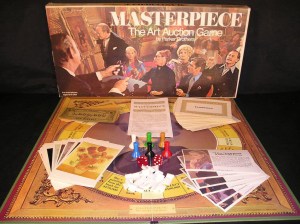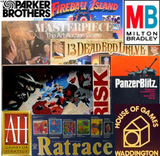There have been many classic board games produced by Parker Brothers throughout the 1970s, but it could be argued that Masterpiece: Parker Brothers’ Art Auction Game was not only the first of the decade, but also the best.
Masterpiece is a fun game to play. Players take the role of art dealers and collectors, seeking to acquire famous paintings and sell them for insane cash values. The Value cards have random dollar amounts, so although that Van Gogh you picked up is very beautiful, it may be worth as much as $1 million, as low as $150,000 – or (horrors!) may even be a FORGERY! Part of the fun of playing Masterpiece is trying to foist off a worthless painting on your hapless opponents while simultaneously securing a millionaire-making “pièce de résistance”. Not so much fun when it’s done to you, though…
Incidentally, there are no random event cards like “Opportunity Knocks!” that are found in many Parker Brothers games. The only random occurrences come from the role of the dice, the squares on the game board, and the value cards you pick up. Everything else is based on the Art of the Deal.
There have been several version of Masterpiece, beginning in 1970, with editions produced in 1976 and 1996, along with both a Canadian and variant edition of the original 1970 game, too. (Which makes three versions of the 1970 Masterpiece game that I’ve seen.)
The standard American version of Masterpiece is characterized by:
- The game box is in English only.
- A green-backed game board
- Play money with denominations colored in gray ($50,000), yellow ($100,000), brown ($500,000), and olive green ($1,000,000).
- The play money says “Masterpiece” on the top and the value on the bottom.
- There are 24 Value cards, measuring 14cm x 9cm (5.5” x 3.5”)
- There are 6 Value Chart cards with both a list of the available values in the Value card deck, as well as the bios of the characters seen on the box front. (These cards are the same size as the Value cards.)
- There are 24 Painting cards (sized the same as the value cards) that contain paintings on display at the National Gallery in London, England, such as Vincent Van Gogh’s Sunflowers, Paul Cézanne’s Aix: Paysage Rocheux, Leonardo da Vinci’s Cartoon: The Virgin and Child with SS. Anne and John the Baptist, Pierre-Auguste Renoir’s Les Parapluies, and Claude-Oscar Monet’s The Beach at Trouville.
The 1970 Canadian version of Masterpiece has a few differences from its American cousin:
- The game box has slightly darker tones and richer colors, with both English and French on the cover.
- The game board has a dark brown backing (the front is the same as the standard version)
- The play money has denominations colored in yellow ($50,000), brown ($100,000), olive ($500,000, and blue ($1,000,000).
- The play money has English on the bottom and French on the top (for example: One Million and Un Million). The word “Masterpiece” is not written on the play money.
- The Value Chart cards have no character bios on them.
The variant 1970 Masterpiece US edition is a game that I’ve only seen once before, which leads me to believe that it is quite rare. It is similar to the standard 1970 US edition, but has a completely different Painting card set, featuring paintings on display at the Art Institute of Chicago, such as Hans Hoffman’s The Golden Wall, Peter Blume’s The Rock, Edward Hopper’s Nighthawks, Grant Wood’s American Gothic, Vincent Van Gogh’s Self Portrait, and Pablo Picasso’s Sylvette (Portrait of Mlle. D.)
The game remained remarkably unchanged in its 1976 release. The only changes from the 1970 Masterpiece US standard version were the box color (now a green-tinged motif) and the box art (with talking paintings replacing the art auction characters). All other components looked to be leftovers from the original 1970 game.
The 1996 version brought back the concept of art auction characters on the cover (featuring a rather surprised bimbo surrounded by a variety of other characters), with a red-tinged background. As with the 1976 version, there are no character bios on the Value Chart Cards, but a box insert discusses each of the art collector characters in detail. The Value cards are tiny – 7.5cm x 4.5 cm (3” x 1.8”) – and at 42, there are many more of them! The play money has much higher denominations, with denominations of $500,000, $1,000,000, $5,000,000, and $10,000,000. Also, a plastic art display easel was included to aid in the the auctioning process. Finally, the Painting cards remain the same size as previous editions, but feature different paintings from the Art Institute of Chicago, such as Paul Cézanne’s The Basket of Apples, Edward Hopper’s Nighthawks, James Abbott McNeill Whistler’s Violet and Silver – The Deep Sea, Paul Gauguin’s Old Women of Arles, and Vincent van Gogh’s The Bedroom.
One aspect of playing Masterpiece that is easily overlooked yet is possibly one of the most compelling reasons to play the game is how it encourages art appreciation. The paintings are reproductions of the originals, and each art card shows the artist’s name, the painting’s name, what period the artist lived in, and where the painting hangs today (well, where it was when the game was made). This can lead to discussions on art history, examples of movements that swept through the art world, anecdotes on the artists, and more. This could be a home schooling family’s best art appreciation class ever!
Masterpiece is a game for 3 to 6 players, with a recommended starting age of 12 – which is reasonable considering the skills needed to succeed at the game. It’s a game I fondly remember, and recommend wholeheartedly to anyone with a love of fine art and great games!
Filed under: Board Games, Retro Gaming, The Best Classic Board Games | Tagged: 1970, 1976, 1996, art auction, game, masterpiece, parker brothers |

















Good post. I study one thing more difficult on totally different blogs everyday. It will at all times be stimulating to learn content material from other writers and observe a little bit something from their store. I’d choose to make use of some with the content material on my weblog whether you don’t mind. Natually I’ll offer you a link on your web blog. Thanks for sharing.
Muchos Gracias for your blog.Thanks Again. Much obliged.
I do not believe that the 1970 American variant version is rare. The version I played as a child had the Art Institute of Chicago paintings, and almost all 1970 versions currently selling on ebay have the Chicago set. To the contrary, I believe the 1970 version featuring paintings from the National Gallery in London is much harder to find.
[…] first time that I heard about Jackson Pollock was playing a board game, called Masterpiece. Parker Brothers published the game in 1970. It is now out of print. The game consisted of […]
i have a 1970 version of the game, it is in good condition but is missing the instructions a black & green players and has some ripped corners on the box. Any ideas on it worth?
For the 1970 US edition, can you tell me the number of each denominations.
colored in yellow ($50,000)= # of yellows
brown ($100,000)= # of browns
olive ($500,000)= # of olives
blue ($1,000,000)= # of blue
I am trying to determine the amount of money in each edition.
Thank you.
Would love to give you an answer, but haven’t seen a US version Masterpiece game for a few months now.
[…] Is it a forgery? Posted on September 16, 2011 by cwright21 Board games are an essential part of family time, childhood, and adulthood. The games we choose to play, on some level, reflect our interests. Some people love Monopoly and therefore real estate, economics, trade, or investing. Others like Risk and having plans and strategies, while others are connoisseurs of the arts, either collecting, going to visit museums, or creating. If you are the latter, then you are sure to enjoy Masterpiece. Masterpiece is an art auction game by the Parker Brothers, first released in 1970, that includes famous paintings from masters around the world. There have been two newer productions of the game, with the last one in 1996. Most of the paintings from the 1996 version are visible at the Art Institute of Chicago. Some of these paintings include: Paul Cezanne’s The Basket of Apples, Edward Hopper’s Nighthawks, Van Gogh’s The Bedroom, James Abbott McNeill Whistler’s Violet and Silver-The Deep Sea, and Georgia O’keeffe’s The Cross. The game is composed of twenty four paintings, with money amounts ranging from a forgery to ten million dollars in the newer version, or one million in the old, and additional value cards you can add to your paintings. Players have the option of selling, auctioning, or buying paintings from the bank, and trading with fellow players. At the end of the game, the player with the most amount of money wins. The game is also designed to teach players about the famous pieces of art. On the back of each painting there is the title, dimensions, painter, materials, and where the painting is located. Anyone interested in art or board games needs to have this in their possession. https://magisterrex.wordpress.com/2010/04/28/the-best-classic-board-games-masterpiece-1970/ […]
[…] have been several versions of Masterpiece over the years, and you can read more about that here: The Best Classic Board Games – Masterpiece (1970) This edition of What’s In That Game Box deals only with the standard 1970 version. The […]
Cool site. I found an old looking piece of paper that said “Masterpiece” on the top and 500,000 on it.
So I googled “masterpiece 500,000 money” and your site was numero uno.
Now I know i have play money from the 1970 or 1976 game.
Thank-you very much! Hoody-hoo!
Social comments and analytics for this post…
This post was mentioned on Twitter by magisterrex: The Best Classic Board Games – Masterpiece (1970): http://wp.me/pBb2X-9y…
[…] This post was mentioned on Twitter by magisterrex – Dan. magisterrex – Dan said: The Best Classic Board Games – Masterpiece (1970): http://wp.me/pBb2X-9y […]